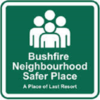A ‘Neighbourhood Safer Place’ (also known as a ‘Bushfire Place of Last Resort’ or NSP-BPLR) is a place of last resort when all other bushfire plans have failed.
- Locations that may provide some protection from direct flame and heat from a fire, but do not guarantee safety.
- Not an alternative to planning to leave early or not stay and defend your property; they are a place of last resort if all other fire plans have failed.
- An existing location and not a purpose-built, fire-proof structure. It is important to know that many NSP-BPLRs are simply a clearing that provides separation distance from the bushfire hazard (eg. Forest).
- Not to be confused with Community Fire Refuges, Relief Recovery Centres, Recovery Centres or Assembly Areas, each of which have a different and specific purpose.
- Not an appropriate destination when leaving the area early.
- Not a place of shelter from other types of emergencies (eg. To escape rising floodwaters or severe weather events)
- Locations that may provide some protection from direct flame and heat from a fire, but do not guarantee safety.
An NSP-BPLR may be in an open space at a local sports field, foreshore, or park, or they may be located within a community building such as a hall or sports pavilion.
You can recognise an NSP-BPLR by a green and white sign which includes the words:
Bushfire Neighbourhood Safer Place – A Place of Last Resort’, or;

‘Bushfire Place of Last Resort – Neighbourhood Safer Place’.

- NSP-BPLR’s are located across the state in both CFA and FRV response areas.
- NSP-BPLR’s are established by local government across Victoria.
- Not all townships have designated NSP-BPL in the local area.
- To find your nearest NSP-BPLR location, visit the CFA Website and check the ‘Local Information’ page, or click here.
- NSP-BPLR’s are located across the state in both CFA and FRV response areas.
- Visit the CFA website for further information about NSP-BPLR’s such as:
Updated
